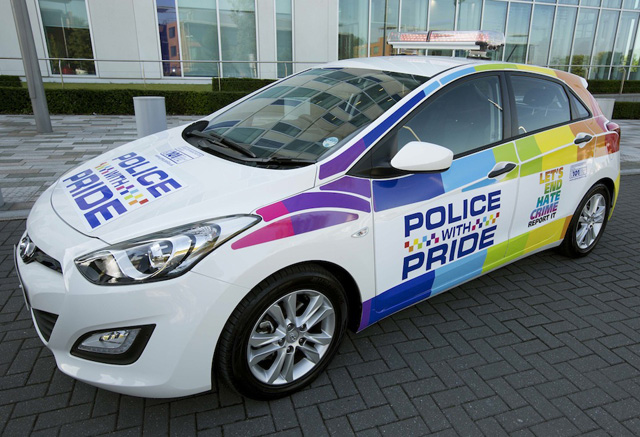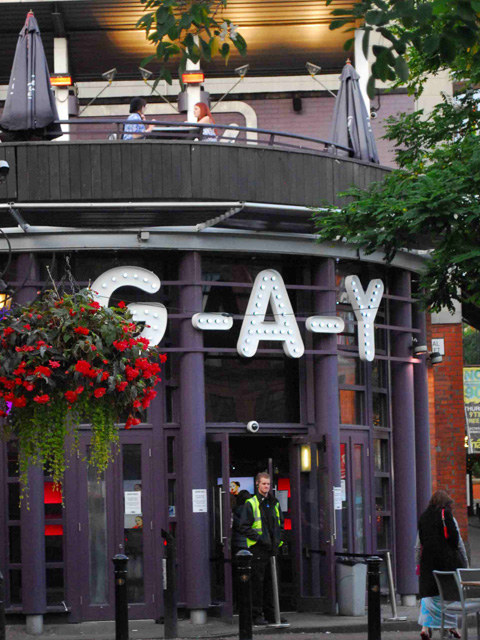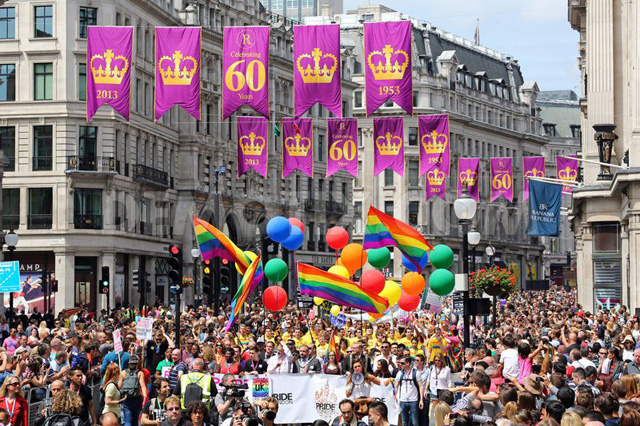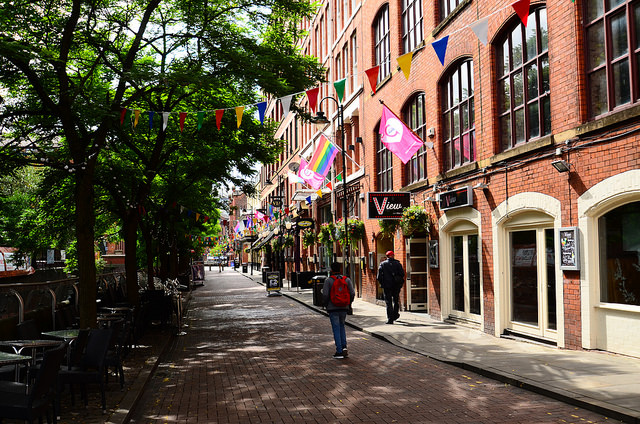
Gay, Interrupted: On Navigating Gaybourhoods As A Queer Brown Woman
“Helloooo,” he lowers his eyelids flirtatiously and giggles, drunkenly clinging onto his partner. Having a markedly low tolerance for street harassment, I am immediately put on edge. I relax a little into the realisation that my friend and I — a trans man and an androgynous lesbian, both small-ish Asians — could easily be mistaken for two gay men ourselves.
Then another voice calls out, “Ni hao!”
I pause. Did he really just say that? How did he, why did he— do I really look Chinese? (Coming from a background of being erased in Chinese-majority environments, that particular remark stung just that little bit more. If we’re going to be dishing out drive-by racism here, my preferred slur is “terrorist.”) Does that even matter? Am I being oversensitive, or overthinking this?
Are we not supposed to be here?
They laugh.
“Fuck you!” I respond, a bit too belatedly.
We’re walking back to our hostel through Manchester’s Gay Village, having just talked about exactly this over dinner: white cis gay men dominating queer spaces. White cis gay men making us feel unsafe and unwelcome; white cis gay men stumbling uncomfortably close to us while yelling “ni hao!” under street signs that warn against the consequences of homophobic hate speech.
A friend shares that the first time she visited a bar in the Village, a drag queen was telling a joke about Chinese folks. Her unanticipated entrance invited an awkward pause, her physical presence selfishly disrupting the previously easy laughter of the audience. That is exactly what navigating gay districts as a queer brown woman often makes you feel like: an interruption.
The first thing you’ll notice about the Village is that it’s really pretty. Being accustomed to the damp grime, broken glass and rowdy crowds of London’s Soho, I’d add unexpectedly pretty. Flowers line the streets that in turn straddle a calm, picturesque canal, the kind that seems like it must have been made to be strolled along and never anything as crude as channelling flows of water. Plastered next to pastel-coloured posters promoting an upcoming trans festival are large, bold signs warning that hate crimes are taken seriously by the Manchester Metropolitan Police. Looking down on all of them are rainbow-coloured street signs declaring, “Smile! You’re on CCTV.”
The place where we had dinner, the Richmond Tea Rooms, is the pinnacle of this. Owned by two men, its over-the-top decor queers the British fetishisation of tea and temperance that tearooms and their associated rituals symbolise. We sat in Alice in Wonderland-themed seats overwhelmed by plush cushions with Heather, who lived nearby and whom we had just met in London a couple of days earlier at an Autostraddle meet-up. She told us that the Village’s main drawback is that it still doesn’t feel safe at night so the flowers and police warnings were part of a recent attempt to “clean up” the area.
There’s an argument for policing trans-, bi- and homophobic violence, of course: according to Stonewall’s 2013 Gay British Crime Survey, 1 in 6 LGB people in the UK had been the victim of a homophobic hate crime or incident in the past 3 years. Stonewall in England & Wales does not (yet) represent the trans community, but trans people, especially trans women and sex workers, are disproportionately subject to harassment, violence and murder on the streets. The nation’s only memorial commemorating the victims of transphobic hate crimes was set up in the Village in 2013… and vandalised just days after.
What’s less clear is whether there’s as strong a case for the police to be doing it. Urban gay neighbourhoods, whether in Manchester, London or elsewhere, almost always arose from the fear of queerphobic violence, sociopolitical disenfranchisement, and the criminalisation of sex and sex work — all of this frequently at the hands of the police. All of this still frequently happens at the hands of the police, so it’s worth asking: are the pride flags decorating blue uniforms today a sign of the times or simply of short-term memory?

If we slap a rainbow on it can we call it even on decades of violence now?
via motors.co.uk
Criminal justice system reform is slowly working its way into the LGBTQ activist consciousness, but not without its hiccups. At a Dyke March in 2013, a well-known queer feminist added anti-police chants to the event’s usual rally cries as we marched through the heart of central London. Responding to those who grumbled about her going off-message (including a police officer who nudged a march participant near me and asked quietly, “What did we do?”), she later added on Twitter that if we couldn’t see how all police were scum, we weren’t thinking intersectionally enough. Fair. Maybe.
Here’s the thing though: if she had been thinking “intersectionally” enough, she would have known that had the policewomen been sufficiently provoked, it is not her, a white woman, who would have been hauled off to jail and kept there. It is not her, a British citizen, who would have been asked to leave the country. It is not her name and her face which would have made headlines the next day. Corralled between police officers with the authority to arrest us and white anarchists with little personally at stake if they did, my enthusiasm about participating in a public queer event for the first time gave way to unease and insecurity. It’s important to recognise that we do not want to invite the mechanisms of state violence and surveillance into our spaces and onto the most vulnerable members of our communities, but surely the solution can’t lie in offering up their bodies to make a political point.
Earlier that day Jeremy and I had been reading through TripAdvisor reviews, taking perverse pleasure (as we queers do) in the hurt feelings of straight people who cried oppression when their hens do in the Village were ruined by, you know, actual gay folks. “If people think homophobia is bad, go and see first hand the hetrophobia (sic) on display at G-A-Y!!” declares one. Another grumbles about “staff watching normal straights all the time” (emphasis mine), while my personal favourite makes a gloriously revealing typo in stating, “as a straight person I feel prejudiced on occasions.”
“If a typically ‘straight’ venue treated people like this they’d be sued for discrimination! However I don’t let it bother me (because it really doesn’t) and continue my night elsewhere.” (I imagine the unwritten part of the review goes, “Specifically, in front of my computer, writing a lengthy online diatribe about things that totally didn’t bother me at all.”)
“Sort it out, we all want to be in a prejudice free world.”
Yeah. Don’t we all. These reviews got across the point loud and clear that straight folks really, really do not enjoy being left out of G-A-Y, perhaps similar to how queer people do not like being excluded from healthy family environments, the right to self-determination and expression, employment and education opportunities, media and political representation, and life itself.

You’d think the name would have tipped them off, but nope.
via John Coxon Photography
Unfortunately I struggle to empathise with the stresses of having to find a night scene friendly to heterosexuals even after going through pages and pages of similarly worded reviews, but one comment that really gave me pause was one that was meant to be a positive endorsement of the Village:
“It is a popular destination for Hen parties and they’re welcome in most bars […] and you will spot a drag queen or two whilst wandering from bar to bar!”
You will spot a drag queen or two. Maybe if you’re lucky!
Signalling another massive shift from the days of sex in the bushes (well, the days of more sex in the bushes), gay districts are now tourist attractions promoted by city councils on glossy brochures and rainbow-themed (of course!) webpages. Part of this is because of the massive urban rejuvenation efforts that have transformed gaybourhoods worldwide in the past few decades, whether from funder-backed urban redevelopment projects or the steady gentrification of white, middle-class gays, making them safe, alluring destinations for the curious wanderer looking for an “alternative” night out. Yet part of this — the part that is not anything new, and definitely not anywhere near progressive — is because queer people have always been seen as tourist attractions. It’s just that now we’re more easily and acceptably consumed in moderate, measured doses within designated areas.

Liberation™, brought to you by Barclays. (You might even spot a drag queen or two!)
via Dos Manzanas
In going from private closet to public spectacle, shady neighbourhood to international attraction, have we really reclaimed pride from shame or played into dynamics of commodification and assimilationism to our detriment? There’s no easy way to talk about The Man here when the mainstreaming of gay culture has, for many, made it possible to survive and even thrive. Gay’s the Word might never be the radical socialist space it once could have been, but neither does it invite the suspicion and sabotage it once did. Pride marches are now sponsored by big corporations with dodgy politics and even worse labour practices, but they also inspire vulnerable queer youth to imagine futures that aren’t crushing dead-ends. Playing straight, playing for straights — at-risk queers have long learnt how to make heterosexuality and capitalism work for them to survive. But let’s also not kid ourselves in thinking that the respectability politics that underlie the progress of the LGBTQ “community” has uniformly made it better for all, when sex workers and saunas are swept away to make space for parties and wedding proposals. Gay districts are safer, more open and more profitable than ever before, but for whom?
As I’m trying to get a grasp on what gay districts stand for and how we should preserve this, it’s funny enough to think of straight tourists being side-eyed by butch bouncers but decidedly less amusing when I think back to how at a London Autostraddle meet-up in 2012 our tiny assemblage of queer women was rejected entry into a bar in Soho. The bouncers weren’t convinced we were gay, even though we probably collectively had more piercings than hair on the left sides of our heads. Do we have to perform gay to be allowed to be gay in public? How do we do this, when “looking gay” is inherently coloured by class, race and gender? Queer women and men alike have adopted variations on the “working class” attires of flannel shirts and combat boots as queer uniforms, for instance, but it’s hard to say if a queer Sun-reading Mancunian man would pass G-A-Y’s bouncers’ tests as easily as a young skinny boy in a deep V-neck t-shirt. Muslim women participating in gay pride marches get called “suicide bombers,” while white women in rainbow niqabs are applauded for their courage in bringing to light the struggles of poor, third world brown queers. And that one time our ragtag group of mostly ladyqueers got turned down in Soho is just one of many incidents of queer women’s sexualities being disbelieved, trivialised and invisibilised. Endless media and activist discussions of homophobia and sexism — on “fag hags,” on bachelorette parties in gay bars, on gay men feeling entitled to touching women’s bodies — take as their opposing players gay men and straight women, ignoring the queer and trans women whose bodies make up the battleground.
The gendered dynamics of gay spaces extend far beyond the policing of “looking gay” at bar entrances, of course, whether we’re talking about the gender divide between the Castro and Oakland because of economic disparities between gay men and women, or feminist and lesbian spaces (particularly bookstores) and the organisations behind them being chronically underfunded and frequently the butts of jokes in gay media, including in everyone’s latest favourite tearjerker, Pride. (Don’t get me wrong, it is an excellent film that I strongly recommend. Yet it unfortunately also follows in a long-established tradition of trivialising queer women’s needs for their own spaces.) The year that I arrived in London, First Out Café, the city’s first daytime gay venue, closed. The year that I left, Candy Bar, the biggest (and only wheelchair-accessible) lesbian bar, followed suit. This isn’t unique to London, as many other spaces that cater primarily cater to queer women and other folks struggle to survive while gay men’s clubs and bars thrive. As Carmen writes from DC, “It’s not possible for us to know, just yet, how our community will change now that we don’t have a central place to house it.”
I know intimately the promise and allure of gay districts, even as someone whose fullest extent of engagement with “the scene” is often just standing awkwardly in a corner sipping a mocktail while friends unsuccessfully implore me to dance. As an 18-year-old in London, newly arrived from a home very far away, my first night in the basement of Ku Bar — on the one night they have designated for women — was eye-opening. I was intimidated by the alcohol, loud music and physical intimacy, but I’d never been in a room with that many queer people before and it was affirming in a way I didn’t even know I needed it to be. Particularly memorable for me was a moment when a middle-aged Chinese lady whose business wear resembled that of the homophobic principal of my junior college casually walked past, wineglass in hand.
Neither are gay districts necessarily now devoid of hope for me. In my last week in London I finally caught Soho’s annual Village Fête, which gave space to community groups, queer performers, and the odd and brilliantly endearing waiters’ race, in which waiters well, race, along Old Compton Street balancing a wine bottle and glass on a tray. Instead of the Metropolitan Police, the Fête was cared for by the Lesbian & Gay Foundation’s Angels in pink fluorescent vests, who were borrowed from Manchester’s Gay Village and whose first job was to listen to whatever people needed to say and to provide support where necessary, whether it was directions, a safe ride home, or yes, a police call.
Still, that first time I left that gay bar in Soho, I was mainly afraid of running into people I knew from back home. (Like Manchester, the gay district in London is right next to the city’s Chinatown, which doesn’t do much to assuage the fears of closeted queer Asians like I was then.) I didn’t know then to be wary, instead, of those I’d just shared the small, dark basement with. I hadn’t expected then that the vast majority of racism and sexism I’d experience in my three years in London — whether it was yelled at me on the streets or calmly, condescendingly expressed in meetings about the rightful “priorities” of the LGBTQ movement — would be from other queer people.
Gay districts are constructed as havens, as sanctuaries, as places where expression and identity can freely tumble forward in messy, drunken messes. But this glosses over the realities of those of us who are policed for not being gay enough or for being too queer, for dressing wrong, for looking wrong, for being wrong; this doesn’t confront the complexities of police and policing at the intersections of queerphobia, racism, sexism and classism. This picture simply moves on past the interruptions that unruly bodies present, the disruptions to social norms that gave rise to gaybourhoods in the first place. This picture prioritises comfort over challenge, compromising the promise of safety and welcome that these neighbourhoods are supposed to stand for for those of us who aren’t white cis gay men. Who are the “gays” for whom gay districts are built (around)? Who gets to decide?
Are we not supposed to be here?
